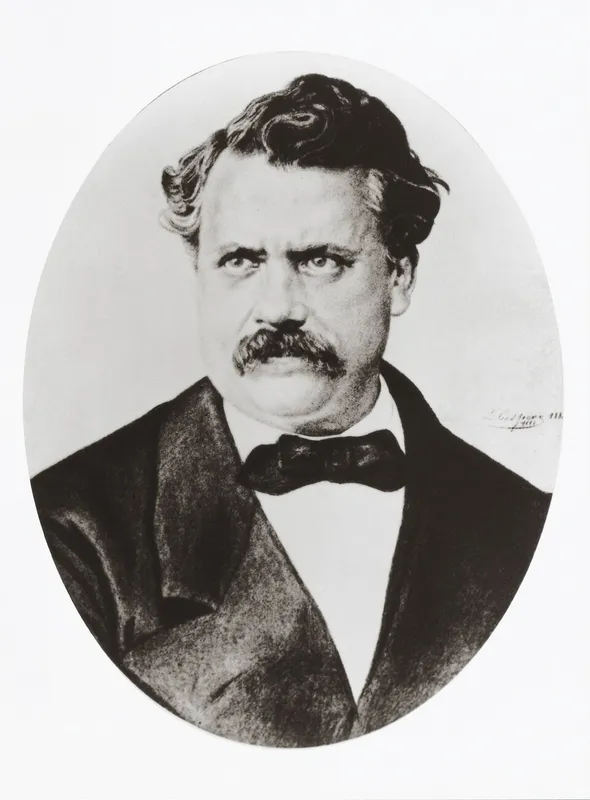Louis Vuitton: From Humble Beginnings to a Global Fashion Icon
A Legacy Born in the Heart of France
In 1821, in a small village in eastern France, a boy named Louis Vuitton was born. From a young age, he displayed remarkable craftsmanship skills, which eventually led him to Paris. By the mid-19th century, Vuitton became an apprentice to a successful box maker and packer, where he learned the art of creating custom trunks for wealthy clients. In 1854, he opened his own workshop at 4 Rue Neuve-des-Capucines in Paris, laying the foundation for what would become one of the most recognizable fashion brands in history. His innovation was simple yet revolutionary: flat-topped trunks made of lightweight, durable canvas that could be stacked, unlike the rounded-top trunks of the era.

Portrait of Louis Vuitton, founder of the luxury brand. Public Domain, Wikimedia Commons
Building a Family Empire
Louis Vuitton was more than just a craftsman — he was a visionary. By the late 1800s, his trunks were in demand among aristocrats, explorers, and artists across Europe. In 1888, the Vuitton family introduced the now-famous Damier canvas pattern to combat counterfeiting — a problem even in those early days. This was a time when luxury goods were symbols of prestige and durability, and Vuitton’s creations were unmatched in both. The family-run business became a hallmark of French elegance, passing knowledge and design principles from one generation to the next.

The Vuitton family posing together in 1888, showcasing the heritage behind the brand. Public Domain, Wikimedia Commons
Expanding Through Innovation and Marketing
In the 1920s, Louis Vuitton embraced modern advertising techniques. The brand’s marketing was sophisticated, targeting wealthy travelers and positioning Vuitton trunks as essential for luxury voyages. One notable 1923 advertisement depicted the brand’s Paris store and its exclusive clientele, signaling a shift from pure craftsmanship to a well-orchestrated luxury image. This period also marked a rise in the brand’s popularity with international elites, especially as global travel became more accessible.

1923 Louis Vuitton advertisement promoting the luxury travel lifestyle. Public Domain, Wikimedia Commons
The Craft Behind the Masterpieces
By the turn of the century, Vuitton had become synonymous with high-quality travel goods. Their trunks were not just containers — they were works of art. The 1892 catalogue featured designs like the “Malle-Lit,” a trunk that transformed into a bed, intended for explorers in remote locations. Each trunk was custom-made, often taking weeks to complete, with artisans ensuring every detail met exacting standards.

A Louis Vuitton travel trunk from 1923, showcasing craftsmanship and durability. Public Domain, Wikimedia Commons
Iconic Designs and Patterns
Louis Vuitton’s designs stood out for their innovative use of materials and aesthetics. The Damier canvas, followed by the iconic LV monogram created in 1896 by Louis’s son Georges Vuitton, became a hallmark of authenticity. The monogram was both a tribute to his father and a clever way to prevent imitation. Vuitton’s catalogue from the late 19th century displayed not only trunks but also picnic baskets, vanity cases, and other specialized travel items.

1892 Louis Vuitton catalogue featuring the innovative “Malle-Lit” bed trunk. Public Domain, Wikimedia Commons
Antique Vuitton Pieces Today
Today, antique Louis Vuitton trunks are considered treasures of design history. Their sturdy construction has allowed many to survive in pristine condition, making them highly sought-after by collectors. Photographs from luxury boutiques, such as the Madrid display in 2016, show how these century-old designs still hold their elegance.

Antique Louis Vuitton Trianon luggage on display in Madrid, 2016. Photo: David Adam Kess, CC-BY-SA 4.0, Wikimedia Commons
Louis Vuitton in Everyday Life
Louis Vuitton has long been more than a symbol of wealth. For many, it represents a piece of travel history. An iconic image from the mid-20th century shows a Louis Vuitton trunk accompanying a diplomat’s wife at Schiphol Airport in the Netherlands — a testament to the brand’s enduring association with global travel and sophistication.

Diplomat’s wife departing Schiphol Airport with a Louis Vuitton trunk. Author Hans van Dijk, CC-BY-SA 3.0, Wikimedia Commons
Honoring the Founder
Louis Vuitton passed away in 1892, leaving behind a legacy that his family would continue to build upon for generations. His final resting place in the Asnières-sur-Seine cemetery in France is visited by admirers of the brand who see him not just as a businessman, but as an artist and visionary.

The grave of Louis Vuitton in Asnières-sur-Seine, France. Public Domain, Wikimedia Commons
Louis Vuitton at Auction
In recent years, Louis Vuitton trunks have fetched astonishing prices at international auctions. A late 19th to early 20th-century trunk, once owned by Mrs. Carnegie, was sold by Sotheby’s as part of its “Fashion Icons” collection. Depending on condition, rarity, and historical significance, antique Vuitton pieces can sell for anywhere from $5,000 to over $100,000. The combination of brand heritage, craftsmanship, and timeless design makes these items more than just luggage — they are pieces of history.

Mrs. Carnegie’s Louis Vuitton trunk from the late 19th–early 20th century, sold at Sotheby’s. 2024 Auction


